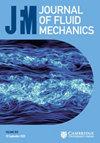负可用势能耗散是双重扩散不稳定性的基本标准
IF 3.9
2区 工程技术
Q1 MECHANICS
引用次数: 0
摘要
本底势能(BPE)是双重扩散不稳定性从没有可用势能(APE)的非强制无运动状态发展时唯一可以利用的能量库。最近,米德尔顿和泰勒(Middleton and Taylor)将背景势能(BPE)提取到 APE 与浮力通量的平滑分量的符号联系起来,但他们的标准只能预测扩散对流不稳定性,而不能预测盐指不稳定性。在这里,我们证明了如果使用 APE 耗散率的符号来代替 APE,就可以纠正这个问题,使其成为双扩散不稳定性的最基本准则。我们提出了双组分流体相对于单组分流体的 APE 耗散率理论,它是三个参数的函数:扩散比、密度比和辣度参数。该理论正确预测了层流非受力状态下盐指和扩散对流不稳定性的发生,同时更广泛地预测了双组分流体的 APE 耗散可以增强、抑制,甚至与单组分流体的 APE 耗散相反,这对海洋混合研究具有重要意义。由于在稳定分层的单组分流体和双重稳定的双组分分层流体中也会出现负APE耗散,我们推测只有热力学的放能理论才能解释其物理现象;然而,这就必须接受APE耗散是APE与BPE的内能分量之间的转换,这与普遍的假设不同。本文章由计算机程序翻译,如有差异,请以英文原文为准。
Negative available potential energy dissipation as the fundamental criterion for double diffusive instabilities
The background potential energy (BPE) is the only reservoir that double diffusive instabilities can tap their energy from when developing from an unforced motionless state with no available potential energy (APE). Recently, Middleton and Taylor linked the extraction of BPE into APE to the sign of the diapycnal component of the buoyancy flux, but their criterion can predict only diffusive convection instability, not salt finger instability. Here, we show that the problem can be corrected if the sign of the APE dissipation rate is used instead, making it emerge as the most fundamental criterion for double diffusive instabilities. A theory for the APE dissipation rate for a two-component fluid relative to its single-component counterpart is developed as a function of three parameters: the diffusivity ratio, the density ratio, and a spiciness parameter. The theory correctly predicts the occurrence of both salt finger and diffusive convection instabilities in the laminar unforced regime, while more generally predicting that the APE dissipation rate for a two-component fluid can be enhanced, suppressed, or even have the opposite sign compared to that for a single-component fluid, with important implications for the study of ocean mixing. Because negative APE dissipation can also occur in stably stratified single-component and doubly stable two-component stratified fluids, we speculate that only the thermodynamic theory of exergy can explain its physics; however, this necessitates accepting that APE dissipation is a conversion between APE and the internal energy component of BPE, in contrast to prevailing assumptions.
求助全文
通过发布文献求助,成功后即可免费获取论文全文。
去求助
来源期刊
CiteScore
6.50
自引率
27.00%
发文量
945
审稿时长
5.1 months
期刊介绍:
Journal of Fluid Mechanics is the leading international journal in the field and is essential reading for all those concerned with developments in fluid mechanics. It publishes authoritative articles covering theoretical, computational and experimental investigations of all aspects of the mechanics of fluids. Each issue contains papers on both the fundamental aspects of fluid mechanics, and their applications to other fields such as aeronautics, astrophysics, biology, chemical and mechanical engineering, hydraulics, meteorology, oceanography, geology, acoustics and combustion.

 求助内容:
求助内容: 应助结果提醒方式:
应助结果提醒方式:


